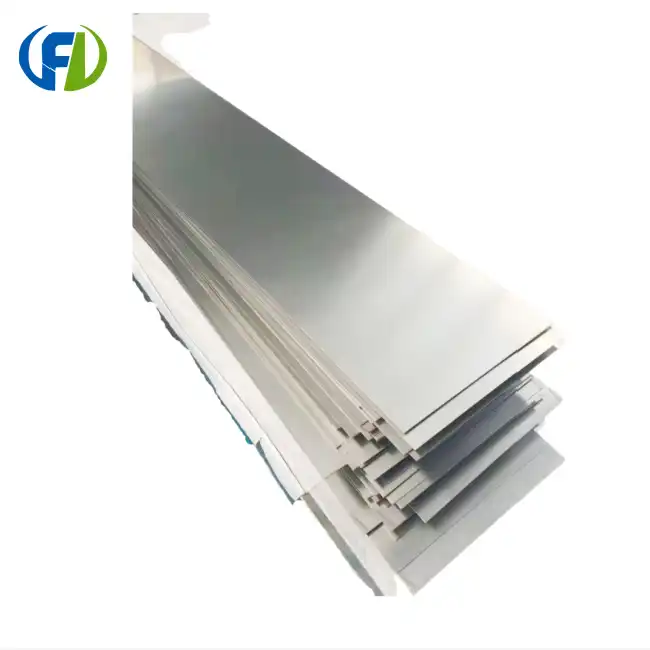The Science Behind Zircaloy-4's Corrosion Resistance
The exceptional corrosion resistance of Zircaloy-4 is rooted in its carefully engineered composition and microstructure. This zirconium alloy's superior performance can be attributed to several key factors:
Protective Oxide Layer Formation
ZrO2 quickly forms a thin, thick layer on top of Zircaloy-4 and Zircaloy-4 Sheet when it comes in contact with oxygen or water, and this oxide layer stops the metal below from rusting any further by acting as a shield, and the alloy's long-term ability to prevent corrosion depends on how stable and well this protective film sticks to it.
Alloying Elements
The addition of specific alloying elements plays a vital role in enhancing Zircaloy-4's corrosion resistance:
- Tin (Sn): Improves mechanical properties and contributes to oxide layer stability.
- Iron (Fe): Enhances corrosion resistance in high-temperature water environments.
- Chromium (Cr): Forms precipitates that help control grain size and improve overall corrosion resistance.
These carefully selected elements work synergistically to create a material that outperforms pure zirconium in corrosive environments.
Microstructure Control
Sheets of Zircaloy-4 and Zircaloy-4 Sheet are also resistant to rust because of how their microstructure is made, and during the making process, precise control of grain size and orientation helps make the material work better, and by lowering the number of possible weak spots in the material's structure, smaller grain sizes usually make it more resistant to corrosion.
Passivation Mechanisms
One important thing that makes zircaloy-4 resistant to rust is that it can self-passivate. When the material is put in an acidic environment, it forms a solid, passive layer that protects against more chemical attack. The passivation process is dynamic, and the protective layer keeps reforming if it gets broken. This makes sure that the protection lasts for a long time.
Long-term Performance in Reactor Environments
Zircaloy-4 plate is great for long-term use in nuclear reactors because it doesn't rust or corkcorrode easily. To show how durable and reliable it is, look at how well it works in these harsh situations.
Radiation Resistance
Materials are exposed to strong radiation fields in the cores of nuclear reactors, and Zircaloy-4 and Zircaloy-4 Sheet is very good at resisting damage from radiation, keeping its structural integrity and ability to fight corrosion even after long-term exposure, and this protection to radiation is very important for making sure that reactor parts are safe and last a long time.
High-Temperature Water Corrosion Behavior
Nuclear reactors operate at elevated temperatures and pressures, often in the presence of high-temperature water or steam. Zircaloy-4's corrosion behavior in these conditions is characterized by:
- Slow, predictable oxide growth rates
- Uniform corrosion patterns
- Resistance to localized corrosion phenomena such as pitting or crevice corrosion
These characteristics allow for accurate prediction of component lifetimes and ensure reliable long-term performance.
Hydrogen Uptake Resistance
One of the challenges in nuclear environments is the potential for hydrogen uptake, which can lead to embrittlement of materials. Zircaloy-4 demonstrates superior resistance to hydrogen absorption compared to many other alloys, helping to maintain its mechanical properties over extended periods of operation.
Fuel Cladding Performance
As a primary material for nuclear fuel cladding, Zircaloy-4 sheet must maintain its integrity throughout the fuel cycle. Its excellent corrosion resistance in reactor coolant environments, combined with its low neutron absorption cross-section, makes it an ideal choice for this critical application. The material's ability to withstand the harsh conditions inside a reactor core while minimizing parasitic neutron absorption contributes to improved fuel efficiency and reactor performance.
Maintenance and Inspection of Zircaloy-4 Components
While Zircaloy-4 plate exhibits exceptional corrosion resistance, proper maintenance and inspection protocols are essential to ensure optimal performance and longevity of components made from this material.
Non-Destructive Testing Techniques
Regular inspection of Zircaloy-4 components is crucial for early detection of potential issues. Several non-destructive testing (NDT) methods are employed:
- Ultrasonic Testing: Used to detect internal flaws or measure oxide layer thickness.
- Eddy Current Testing: Effective for surface and near-surface defect detection.
- Visual Inspection: Often enhanced with specialized cameras for hard-to-reach areas.
These techniques allow for thorough examination without compromising the integrity of the components.
Surface Cleaning and Passivation
Periodic cleaning and repassivation of Zircaloy-4 surfaces can help maintain optimal corrosion resistance:
- Chemical Cleaning: Removes contaminants and oxide buildup without damaging the base metal.
- Mechanical Cleaning: Carefully applied to avoid introducing surface defects.
- Passivation Treatments: Enhance the protective oxide layer, particularly after machining or repair operations.
These maintenance procedures help ensure the continued effectiveness of Zircaloy-4 and Zircaloy-4 Sheet's inherent corrosion resistance properties.
Monitoring and Data Analysis
Continuous monitoring of Zircaloy-4 components in service provides valuable data for predicting long-term behavior:
- Corrosion Rate Tracking: Regular measurements of oxide layer growth help forecast component lifetimes.
- Environmental Parameter Monitoring: Tracking factors such as temperature, pressure, and water chemistry aids in understanding corrosion mechanisms.
- Predictive Modeling: Advanced computer simulations use collected data to predict future performance and optimize maintenance schedules.
This data-driven approach allows for proactive maintenance strategies, minimizing downtime and extending the service life of Zircaloy-4 components.
Repair and Replacement Strategies
Despite its durability, Zircaloy-4 components may eventually require repair or replacement:
- Weld Repair Techniques: Specialized welding procedures maintain the material's corrosion resistance in repaired areas.
- Strategic Replacement: Phased replacement of components based on predictive models and inspection results.
- Material Upgrades: Consideration of newer zirconium alloys for specific applications where enhanced performance is required.
These strategies ensure that the benefits of Zircaloy-4's corrosion resistance are maximized throughout the lifecycle of engineered systems.
Conclusion
As a key material in many fields that need to work well in harsh conditions, Zircaloy-4 plate and Zircaloy-4 Sheet is very good at not rusting, and because it is stable and lasts a long time, zircaloy-4 is used in many fields, from nuclear energy to chemical processing to airplanes, and knowing how well Zircaloy-4 works in reactors over time, how its science works to keep it in good shape, and how important it is to check it often shows that it is still at the cutting edge of materials technology.
For those seeking high-quality Zircaloy-4 products and expert guidance, Baoji Freelong New Material Technology Development Co., Ltd. stands ready to meet your needs. Located in Baoji City, China's Titanium Valley, we specialize in the production and OEM of zirconium, titanium, nickel, niobium, tantalum, and other advanced alloys. Because we care about quality and service, clients believe us from Australia, Korea, Germany, the US, the UK, Malaysia, the Middle East, Taiwan, and other places. We're proud that we always meet or beat our customers' expectations when it comes to quality.
To learn more about our Zircaloy-4 offerings and how they can benefit your projects, please contact us at jenny@bjfreelong.com. Our team of experts is ready to provide you with the superior materials and support you need for your most demanding applications.
References
1. Cox, B. (2005). Some thoughts on the mechanisms of in-reactor corrosion of zirconium alloys. Journal of Nuclear Materials, 336(2-3), 331-368.
2. Motta, A. T., Couet, A., & Comstock, R. J. (2015). Corrosion of Zirconium Alloys Used for Nuclear Fuel Cladding. Annual Review of Materials Research, 45, 311-343.
3. Adamson, R., et al. (2007). Corrosion mechanisms in zirconium alloys. ASTM Special Technical Publication, 1467, 515-539.
4. Lemaignan, C., & Motta, A. T. (1994). Zirconium Alloys in Nuclear Applications. Materials Science and Technology.
5. Yilmazbayhan, A., et al. (2006). Structure of zirconium alloy oxides formed in pure water studied with synchrotron radiation and optical microscopy: relation to corrosion rate. Journal of Nuclear Materials, 349(3), 265-281.
6. Garner, A., et al. (2014). The microstructure and microtexture of zirconium oxide films studied by transmission electron backscatter diffraction and automated crystal orientation mapping with transmission electron microscopy. Acta Materialia, 80, 159-171.


_1744707571374.webp)
_1745889548621.webp)
_1745821959752.webp)
_1745389379051.webp)